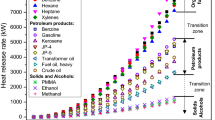Abstract
This paper describes the development of a three-dimensional (3D) physics-based fire simulation model that employs the incompressible Navier–Stokes equations to realistically emulate the combustion process. Then, we animate the 3D interactive burning processes by rendering a flame under a set of influence factors and with various solid boundaries and obstacles. It is insufficient to simply create a virtual reality-based fire model. Instead, evaluating the similarity and accuracy of the models requires data processing for the virtual flames. In this paper, detailed data are extracted from the simulation results to compute the fire’s geometrical features and the distribution of the density and velocity fields. Using methods for video-based fire detection, some visual features of the simulated-fire videos are extracted and compared with those of real fires. The results show the capability of the physics-based fire model in representing some features of real flames. The proposed quantitative analysis of virtual flames serves to evaluate the similarity between a virtual and a real fire.















Similar content being viewed by others
Explore related subjects
Discover the latest articles, news and stories from top researchers in related subjects.References
Borges PVK, Izquierdo E (2010) A probabilistic approach for vision-based fire detection in videos. IEEE Trans Circuits Syst Video Technol 20:721–731. https://doi.org/10.1109/tcsvt.2010.2045813
Bridson R (2008) Fluid simulation for computer graphics. A K Peters/CRC Press, New York
Çetin AE, Dimitropoulos K, Gouverneur B, Grammalidis N, Günay O, Habiboǧlu YH, Töreyin BU, Verstockt S (2013) Video fire detection–review. Digit Signal Process 23:1827–1843. https://doi.org/10.1016/j.dsp.2013.07.003
Cha M, Han S, Lee J, Choi B (2012) A virtual reality based fire training simulator integrated with fire dynamics data. Fire Saf J 50:12–24. https://doi.org/10.1016/j.firesaf.2012.01.004
Chiba N, Muraoka K, Takahashi H, Miura M (1994) Two-dimensional visual simulation of flames, smoke and the spread of fire. J Vis Comput Anim 5:37–53. https://doi.org/10.1002/vis.4340050104
Chorin AJ, Marsden JE (1990) A mathematical introduction to fluid mechanics. Springer, New York
Ferziger JH, Peric M (2002) Computational methods for fluid dynamics. Springer, Berlin
Foster N, Fedkiw R (2001) Practical animation of liquids. In: Proceedings of the 28th annual conference on computer graphics and interactive techniques. ACM, Los Angeles, pp 23–30
Foster N, Metaxas D (1996) Realistic animation of liquids. Graph Model Image Process 58:471–483. https://doi.org/10.1006/gmip.1996.0039
Harlow FH, Welch JE (1965) Numerical calculation of time-dependent viscous incompressible flow of fluid with a free surface. Phys Fluids 8:2182–2189. https://doi.org/10.1063/1.1761178
Horvath C, Geiger W (2009) Directable, high-resolution simulation of fire on the GPU. ACM Trans Graph 28:41. https://doi.org/10.1145/1531326.1531347
Inakage M (1990) A simple model of flames. In: Chua TS, Kunii TL (eds) CG international ’90. Springer, Tokyo, pp 71–81
Kajiya JT, Von Herzen BP (1984) Ray tracing volume densities. In: Proceedings of the 11th annual conference on computer graphics and interactive techniques. ACM, New York, NY, pp 165–174
Li J-M, Wu Y-L, Chi Z-X, He R-S (2007) Real-time fire simulation based on fluid model and GPU accelerated. J Syst Simul 19:10
Melek Z, Keyser J (2002) Interactive simulation of fire. In: Proceedings of the 10th Pacific conference on computer graphics and applications. IEEE, Beijing, China, pp 431–432
Moreno A, Posada J, Segura Á, Arbelaiz A, García-Alonso A (2014) Interactive fire spread simulations with extinguishment support for virtual reality training tools. Fire Saf J 64:48–60. https://doi.org/10.1016/j.firesaf.2014.01.005
Nguyen DQ, Fedkiw R, Jensen HW (2002) Physically based modeling and animation of fire. ACM Trans Graph 21:721–728. https://doi.org/10.1145/566654.566643
Perry CH, Picard RW (1994) Synthesizing flames and their spreading. Massachusetts Institute of Technology, Cambridge
Premžoe S, Tasdizen T, Bigler J, Lefohn A, Whitaker RT (2003) Particle-based simulation of fluids. Comput Graph Forum 22:401–410. https://doi.org/10.1111/1467-8659.00687
Reeves WT (1983) Particle systems—a technique for modeling a class of fuzzy objects. ACM Trans Graph 2:91–108. https://doi.org/10.1145/357318.357320
Stam J (1999) Stable fluids. In: Proceedings of the 26th annual conference on computer graphics and interactive techniques. ACM Press/Addison-Wesley Publishing Co, Los Angeles, pp 121–128
Stam J (2000) Interacting with smoke and fire in real time. Commun ACM 43:76–83. https://doi.org/10.1145/341852.341866
Stam J (2003) Real-time fluid dynamics for games. In: Proceedings of the game developer conference. UBM, London, p 25
Stam J, Fiume E (1995) Depicting fire and other gaseous phenomena using diffusion processes. In: Proceedings of the 22nd annual conference on computer graphics and interactive techniques. ACM, Los Angeles, pp 129–136
Tannehill JC, Anderson DA, Pletcher RH (2011) Computational fluid mechanics and heat transfer. CRC Press, Boca Raton
Töreyin BU, Dedeoğlu Y, Güdükbay U, Çetin AE (2006) Computer vision based method for real-time fire and flame detection. Pattern Recognit Lett 27:49–58. https://doi.org/10.1016/j.patrec.2005.06.015
Williams-Bell FM, Kapralos B, Hogue A, Murphy BM, Weckman EJ (2014) Using serious games and virtual simulation for training in the fire service: a review. Fire Technol 51:553–584. https://doi.org/10.1007/s10694-014-0398-1
Author information
Authors and Affiliations
Corresponding author
Additional information
Publisher's Note
Springer Nature remains neutral with regard to jurisdictional claims in published maps and institutional affiliations.
Electronic supplementary material
Below is the link to the electronic supplementary material.
Supplementary file1 (MP4 3477 kb)
Supplementary file2 (MP4 3393 kb)
Supplementary file3 (MP4 7487 kb)
Rights and permissions
About this article
Cite this article
Zhou, X., Zhang, Y., Chen, G. et al. A model for physics-based fire simulation and analysis. Virtual Reality 25, 421–432 (2021). https://doi.org/10.1007/s10055-020-00465-3
Received:
Accepted:
Published:
Issue Date:
DOI: https://doi.org/10.1007/s10055-020-00465-3




